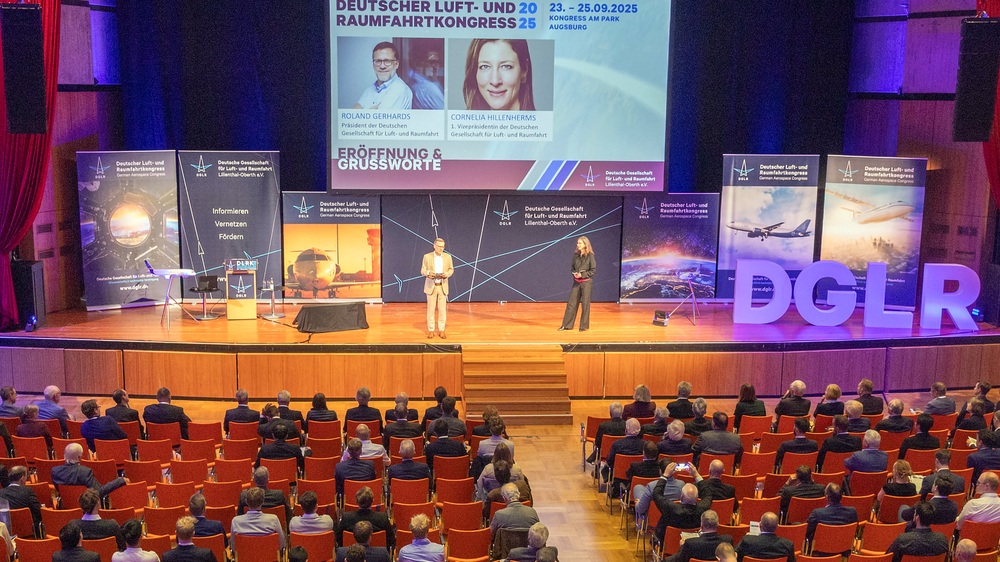DLRK 2025: Research for Safe and Climate-Compatible Aviation

Deutsche Gesellschaft für Luft- und Raumfahrt - Lilienthal-Oberth e.V.
- Contributions on air situation awareness, navigation, drone traffic, and digital analysis tools
- Impulses for safe, efficient, and climate-compatible air transport
Ready for Take-off!” – this motto of DLRK 2025 reflects the spirit of optimism in aerospace. In times of global challenges such as climate change, geopolitical tensions, and economic uncertainties, the congress showed: with evidence-based research and technical innovation, solutions can be developed to make aviation more sustainable, safer, and more efficient.
For the DLR Institute of Air Transport, the congress offered an opportunity not only to present its research on current topics in various scientific contributions, but also to advance it further through direct exchange with other researchers and representatives from industry.
New Concepts for Safety and Navigation
One focus was on how air situation awareness in aviation can be designed to be more flexible and cost-efficient1. Traditional airborne systems rely on large platforms with high technical effort. A distributed solution opens up new, safer possibilities: swarms of small, networked sensor platforms can be deployed flexibly and provide advantages in many scenarios – especially in detecting hard-to-track objects.
Navigation in aviation was also examined from a new perspective2. In order to maintain high-precision performance-based navigation in the event of a failure of satellite-based systems, researchers investigated ground-based alternatives. Analyses show that in addition to DME-based solutions (Distance Measuring Equipment), systems based on LDACS (L-band Digital Aeronautical Communications System) can also provide reliable solutions. This results in a more robust overall system that can ensure safeguarded high navigation accuracy even in continental en-route operations.
Regional Air Mobility and Drone Traffic
Researchers presented new findings on communication systems for drones3. They investigated the ability of drones to establish radio-based connections with each other during flight. Such ad hoc networks could become an important building block for the success of future drone applications – from parcel delivery to urban transport solutions.
Another study focused on how small aircraft can cope with adverse weather conditions4. Icing or reduced visibility represent significant limitations to operational capability. Using statistical analyses, availability indicators were developed to show under which conditions the operation of such aircraft can be reliably maintained. These insights are central to the planning of future mobility services.
Digital Tools for Complex Interdependencies
It is becoming increasingly clear that aviation cannot be considered in isolation. New digital platforms make it possible to bring together various influencing factors and play through scenarios5. For example, the integrated dashboard from the DLR project ALICIA allows the consequences of different technologies or operating strategies to be compared in real time. This makes complex interdependencies visible – and gives decision-makers a tool to sketch out strategies for sustainable aviation.
The DLR Institute of Air Transport contributes applications at the level of the entire air transport system6. A digital platform was presented that enables analysis of climate impacts, life cycles, capacity bottlenecks, or energy demands – also for future scenarios.
In addition, researchers at the Institute are supporting the further development of the data standard CPACS (Common Parametric Aircraft Configuration Schema) 7. By expanding it to include parameters for environmental and economic data, interdisciplinary studies can be carried out with even greater precision in the future.
1Braune-Krickau, D., Hillebrecht, A. “ISR, The Flying Sensor Grid – A Comparison to Conventional Airborne Early Warning”, Presentation at the 74th German Aerospace Congress (Deutscher Luft- und Raumfahrtkongress, DLRK 2025), Augsburg, GER.
2Hillebrecht, A., Marks, T., Weaver, B., Zampieri, G. “Assessing the benefits of LDACS-APNT in continental en-route operations”, Presentation at the 74th DLRK 2025, Augsburg, GER.
3Marks, T., Oikonomopoulos-Zachos, C., Stavrou, E., Fuger, K., Kuladinithi, K., Melzer, B., Hesse, F., Nil, A., Rossbach, A., Laiacker, M., Brinkmeyer, J., “Distributed Position Control in UAS Networks: Challenges and Requirements”, Presentation at the 74th DLRK 2025, Augsburg, GER.
4El Kadaoui, H., Swaid M., Lau, A., “Statistical investigation of operational capabilities of small aircraft under consideration of icing and visual meteorological conditions”, Presentation at the 74th DLRK 2025, Augsburg, GER.
5Ratei, P., Jepsen, J., Bertram, P., Weber, L., Mancini, A., Prakasha, P. S., Baier, F., Gelhausen, M., Clococeanu, M., Niklaß, M., Ehlers, T., Dahlmann, K. “An Integrated System Model and Interactive Dashboard Application for Impact Assessment in Aviation”, Presentation at the 74th DLRK 2025, Augsburg, GER.
6Clococeanu, M., Baier, F., Marks, T., Paramasivam, C., Berster, P., Gelhausen, M., Pabst, H., Chatterjee, S., Kühlen, M., Dahlmann, K., Temme, A., Kuenz, A., Morscheck, F., Alder, M., Weber, L., Bertram, P., Ratei, P., Albano, J. “Demonstration of a Collaborative Digital Platform for Impact Assessment Studies on Air Transport System Level”, Presentation at the 74th DLRK 2025, Augsburg, GER.
7Alder, M., Ratei, P., Clococeanu, M., Chatterjee, S., Kühlen, M., Marks, T., Temme, A., Mancini, A. “Extension of the Common Data Exchange Model CPACS towards Impact Assessment Studies on Air Transportation System Level”, Presentation at the 74th DLRK 2025, Augsburg, GER.
